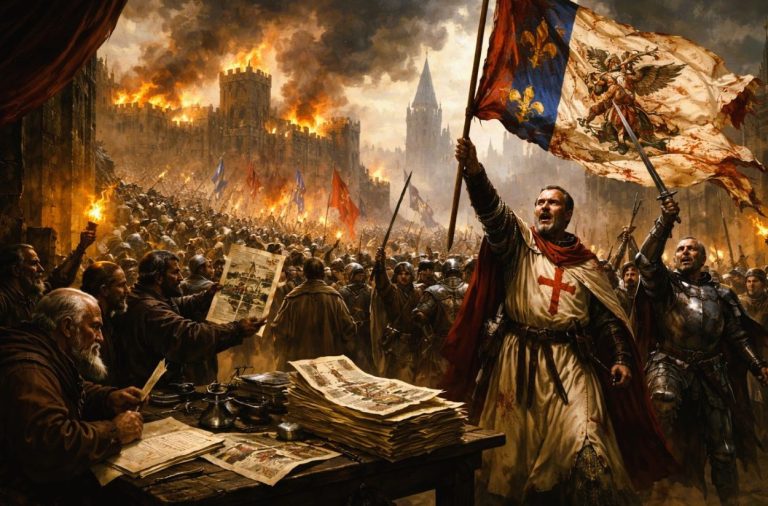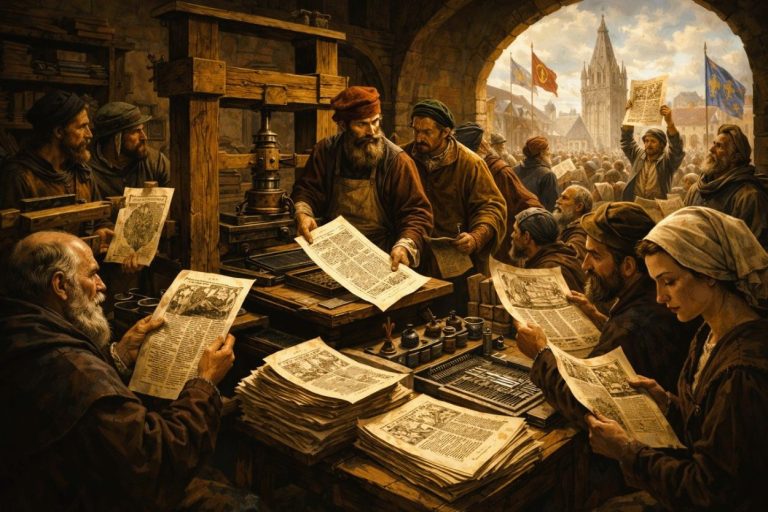

Lives were destroyed not by trials alone but by the mere act of being named. The list was never fully visible, yet it shaped careers, reputations, and entire communities.

By Matthew A. McIntosh
Public Historian
Brewminate
Introduction
Few words strike as much dread as “the list.” To be named on one, whether in rumor or record, carries the aura of guilt without the need for evidence. The McCarthy-era Red Scare weaponized this ancient logic, binding careers, reputations, and livelihoods to rosters of suspicion. What made blacklisting so destructive was not its formality but its secrecy. One might never see the list, never know who compiled it, yet still feel its ruinous effects.
This was not a uniquely American invention. From inquisitorial registers in medieval Europe to Stalin’s purge lists, history has repeatedly demonstrated how societies in crisis turn to hidden rosters of names as instruments of control. Yet the American experiment with blacklisting remains distinctive for its blend of democratic spectacle and covert enforcement. It unfolded not in dungeons but on television screens, and its legacies linger in culture, memory, and politics.
The Political Climate of Fear

The Second World War ended with both triumph and dread. The atomic bomb had secured victory, but it also inaugurated a new epoch of nuclear terror. The United States, facing the Soviet Union as ideological rival, found itself mired in a global contest that demanded vigilance at home as much as abroad.1 In this atmosphere, the fear of communist infiltration proved irresistible.
Joseph McCarthy’s rise hinged on his ability to conjure lists. In a 1950 speech at Wheeling, West Virginia, he claimed to hold in his hand the names of more than two hundred communists working in the State Department.2 The precise number shifted from speech to speech, but the image stuck. The idea that secret rosters circulated within government created a psychological climate where denial offered little comfort.
Beyond McCarthy himself, a broader culture of suspicion permeated American life. Newspapers repeated claims, editorials speculated on hidden enemies, and politicians competed in their zeal to appear vigilant. Lists became less about evidence than about theater, and in that theater, careers could collapse overnight.
Mechanisms of Blacklisting
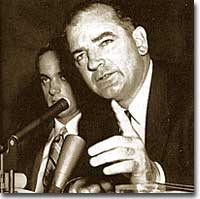
Congressional committees provided the most visible machinery of accusation. The House Un-American Activities Committee (HUAC), revived during the late 1940s, summoned hundreds of witnesses to answer for their alleged affiliations.3 Hearings were staged for maximum effect, often televised, where the act of being called before the committee carried as much stigma as any admission.
Hollywood became the most notorious battleground. The “Hollywood Ten,” a group of screenwriters and directors who refused to answer questions about their political beliefs, were convicted of contempt and imprisoned. Studios swiftly adopted blacklists, refusing to hire anyone suspected of communist ties.4 The practice extended beyond those who testified, ensnaring actors, musicians, and stagehands whose names appeared in pamphlets such as Red Channels.
What made blacklisting particularly insidious was its reliance on private enforcement. No statute mandated that studios fire writers, nor that publishers refuse manuscripts. But fear of public backlash or congressional scrutiny drove institutions to act as though the lists were binding. The result was a patchwork of formal and informal exclusion, where the boundaries of suspicion were deliberately unclear.
Whisper campaigns amplified the effect. Rumors spread quickly, and the absence of transparency allowed innuendo to function as evidence. A person could be barred from employment simply because a producer had heard their name “might be on a list.” The ambiguity itself became a tool of control.
Personal Consequences of Being Named
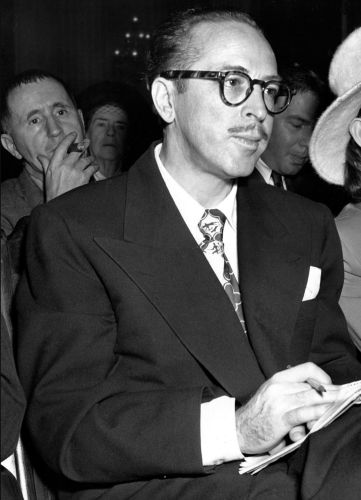
For those inscribed, the consequences were devastating. Loss of work was the most immediate effect. Careers that had taken decades to build collapsed within months, and families were plunged into financial precarity. Some artists left the country, while others adopted pseudonyms to continue their work. Dalton Trumbo, once celebrated, wrote screenplays under assumed names until the 1960s, when he was publicly reinstated.5
The psychological toll was equally severe. To live under suspicion meant enduring social ostracism as well as professional exile. Neighbors turned cold, friends vanished, and communities that had once been vibrant fragmented under the pressure of fear. The sense of internal exile, being present in one’s country but absent from its civic life, marked many blacklisted figures for the rest of their days.
Yet some found ways to reinvent themselves. Musicians performed in small venues far from the limelight; journalists shifted to pseudonymous pamphlets. Reinvention, however, was always partial. The stain of being listed rarely faded completely, and rehabilitation often came only decades later, long after the damage had been done.
Resistance and Complicity
There were acts of resistance, though they came at high cost. The Hollywood Ten refused to testify, declaring that Congress had no authority to police thought. Their defiance landed them in prison but also made them symbols of principled dissent.6 In academia, some professors resisted loyalty oaths, though many more signed them to keep their posts.
Institutions, for the most part, complied. Corporations and unions, fearing association with subversion, adopted exclusionary practices that went beyond what the government demanded. Universities dismissed faculty for refusing to name names, and studios eagerly cut ties with even mildly controversial figures. The logic of suspicion became self-reinforcing.
The most morally fraught dimension was collaboration. Some cooperated with committees, naming colleagues to deflect suspicion from themselves. Others signed public renunciations. The question of complicity remains ethically charged: were these acts betrayals, or desperate attempts at survival in a climate where silence could end one’s career? History offers no easy answer, only the recognition that fear distorts moral choice.
Cultural Memory and Aftermath
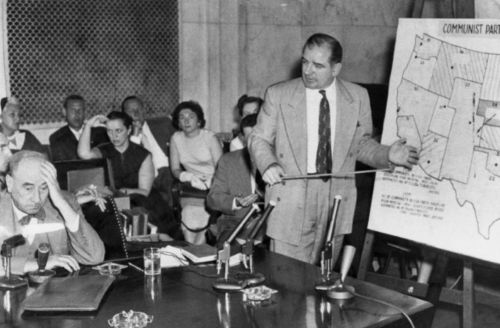
The tide began to turn with the Army-McCarthy hearings in 1954, when McCarthy’s bullying demeanor was broadcast nationwide. “Have you no sense of decency, sir?” became the line that punctured his momentum, spoken by Joseph Welch, counsel for the Army.7 Public opinion shifted, and the Senate censured McCarthy later that year.
Yet blacklisting did not vanish overnight. Many remained unemployable into the 1960s, and the stigma of suspicion lingered. Rehabilitation was uneven, often dependent on political winds. Dalton Trumbo’s public acknowledgment at the 1970 Academy Awards marked one symbolic closure, but countless lesser-known figures never recovered.
The cultural memory of blacklisting has since been woven into film and literature. Works like Good Night, and Good Luck and The Front dramatized its human costs, while biographies and memoirs reconstructed the atmosphere of suspicion. Memory itself became a site of struggle, as communities debated who resisted, who collaborated, and who was unjustly forgotten.
Comparative Reflections
Blacklisting was not an aberration but part of a broader historical pattern. Societies under pressure often turn to hidden registers of the accused. Medieval inquisitors maintained indices of heretics; early modern states compiled rosters of witches; authoritarian regimes in the twentieth century kept files on “enemies of the people.” The McCarthy-era lists belong to this lineage, adapted to an American context.
The distinctive feature of McCarthyism was its theatricality. Whereas inquisitorial registers were secret archives, McCarthy wielded his “lists” as props, claiming to reveal without ever disclosing. The ambiguity itself gave him power. Americans did not need to see the names; they only needed to believe that such names existed. The list became both evidence and myth.
Universities and corporations also mirrored older patterns. Just as medieval guilds excluded those suspected of heresy, American unions and studios purged members for fear of collective taint. The structures differed, but the logic remained: exclusion by inscription, whether formal or whispered.
The modern fascination with “cancel culture” often invokes McCarthyism as precedent. The analogy is imperfect, but it underscores a continuity: societies remain gripped by the anxiety of who is on the list, whether it is published by a committee, whispered through rumor, or circulated on social media. The list endures because it condenses fear into a name.
Conclusion
The McCarthy-era blacklists reveal how fragile democratic institutions become when secrecy and suspicion converge. Lives were destroyed not by trials alone but by the mere act of being named. The list was never fully visible, yet it shaped careers, reputations, and entire communities.
What makes blacklisting particularly haunting is its resonance. Like the Inquisition’s indices or Stalin’s registers, it demonstrates that societies under strain reach instinctively for rosters of the accused. The Red Scare was uniquely American, but its logic was ancient: to bind fear to names, to make the list itself an instrument of power.
Appendix
Footnotes
- Richard M. Fried, Nightmare in Red: The McCarthy Era in Perspective (Oxford: Oxford University Press, 1990), 12–15.
- David M. Oshinsky, A Conspiracy So Immense: The World of Joe McCarthy (New York: Free Press, 1983), 47–49.
- Ellen Schrecker, Many Are the Crimes: McCarthyism in America (Princeton: Princeton University Press, 1998), 212–215.
- Ibid., 294–298.
- Victor S. Navasky, Naming Names (New York: Viking, 1980), 127–134.
- Schrecker, Many Are the Crimes, 302–305.
- Fried, Nightmare in Red, 198–201.
Bibliography
- Fried, Richard M. Nightmare in Red: The McCarthy Era in Perspective. Oxford: Oxford University Press, 1990.
- Navasky, Victor S. Naming Names. New York: Viking, 1980.
- Oshinsky, David M. A Conspiracy So Immense: The World of Joe McCarthy. New York: Free Press, 1983.
- Schrecker, Ellen. Many Are the Crimes: McCarthyism in America. Princeton: Princeton University Press, 1998.
Originally published by Brewminate, 09.16.2025, under the terms of a Creative Commons Attribution-NonCommercial-NoDerivatives 4.0 International license.
